Glorious Gwalior- A peek into the regal past
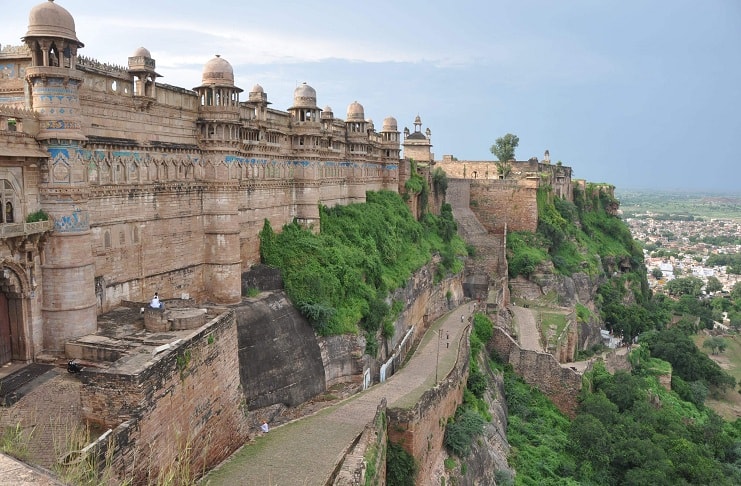
Encircling the majestic hillfort in the centre of the city, Gwalior is a small town about 360 km south of Delhi (MIG Photos/Richa Nigam)
Despite its proximity to Taj Mahal’s home Agra and having plenty of historically significant places that have survived the test of time; Gwalior remains off the regular traveller’s list.
Encircling the majestic hillfort in the centre of the city, Gwalior is a small town about 360 km south of Delhi. It is home to rich heritage age-old stories, myths and songs, especially those associated with various dynasties that ruled over central India.
Winters are the best time to visit the city as its natural beauty comes to full bloom in the cold weather and also because of the famous music festival held in November-December every year. On a cold morning, there’s no better way to start one’s journey of exploring Gwalior’s heritage than visiting the iconic Gwalior fort.
The majestic Gwalior Fort
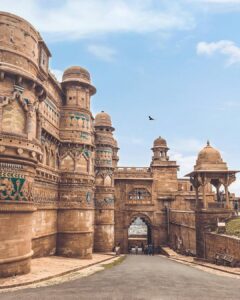
The Gwalior Fort’s main entrance gate – Elephant Gate on the north-east with a long ramp (MIG Photos/Richa Nigam)
Hailed as one of the best-maintained forts of India, the Gwalior Fort, believed to date back to the 6th century, is built on a solitary and steep rocky hill called Gopachal. Local legends say that it was built in 3 CE by a local king, Suraj Sen to welcome a saint named Gwalipa.
Having been conquered by numerous local rulers and Muslim dynasty rulers in turns, the fort has gone through several changes and several smaller monuments have been constructed inside the fort complex, most of which still remain intact and decorated.
With well-maintained premises, the fort complex includes several temples, palaces and ancient water tanks. The palaces here include the Man Mandir Palace, the Gujari Mahal, the Jahangir Mahal, the Shah Jahan Mahal and the Karan Mahal. The fort has two entrance gates: the main entrance being the Elephant Gate on the north-east with a long ramp and the other called the Badalgarh Gate on the south-west side.
At the top of the fort is Gujari Mahal, a rocky structure decorated with colourful mirror work all over its outer walls. It has been converted into state archaeological museum. Adjacent to the Gujari Mahal, stands a beautiful turquoise blue-tiled structure carved out of the topmost rock on the hill and is called Man Mandir Palace. The palace remains open to tourists who wish to sit at the highest point of Gwalior and take in the sights of the city below, along with a small river, Swarnrekha, which flows close to the foot of the hill. True to its name, the flowing water in Swarnrekha river appears golden due to the reflection of the mirrors during the daytime.
In 1844, the Maratha Scindia family of Gwalior, under the protection of the British, occupied the fort. During the rebellion of 1857, the fort saw great warfare – Rani Lakshmibai (the Queen of Jhansi) came fighting from Jhansi to Gwalior and sought shelter inside the fort. Until India gained independence in 1947, the Scindias continued ruling the city and occupied the fort.
Relishing the royal history
After one has gone through the amazing list of monuments in Gwalior Fort, it is time to sit back and enjoy the interesting Light & Sound show that is organized within the fort. The show is organised in Hindi and English languages near Man Mandir Mahal at the Fort’s Amphitheatre.
Duration of the show is for 45 minutes, during which the history of this fort is narrated. Lights are used to create an astonishing visual appeal. The pre-recorded voice narration that one hears is provided by none other than Bollywood actor Amitabh Bachchan with a calm and serene Sitar played by maestro Ravishankar in the background, adding charm to the entire show.
The musical heritage of Tansen
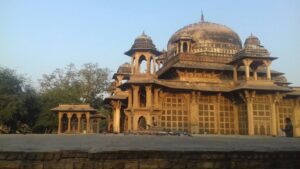
In November every year, the world-famous Tansen Music Festival is organised at the Tansen tomb (MIG Photos/Richa Nigam)
Many such stories and myths remain engraved throughout the city and they are best embodied by Gwalior’s poets and bards across generations, the most notable of them being the famous Tansen.
Just about a kilometer away from the fort, tucked away in a green compound near the resplendent tomb of Sufi saint Mohammed Ghaus, is the small and simple tomb of iconic musician Tansen. One of the nine jewels in the court of Mughal emperor Akbar, Tansen (1500 – 1586), was one of the greatest Indian musicians.
For music lovers and those fascinated by history, the tomb remains a place of avid interest. Gwalior also gets filled with music lovers from all around the world as winter approaches in India as in November every year, the world-famous Tansen Music Festival is organised at the tomb. Generally, the week-long festival reaches to the peak of its glory on the final day when many classical Indian musicians from all over the world perform under one roof throughout the night and audiences remain enchanted till dawn.
Walking through old lanes decorated in modern antics
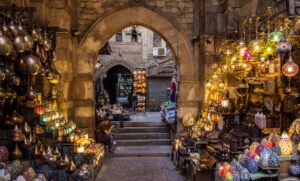
Narrow lanes with twinkling lights can remind some of the Harry Potter shopping world and of old, royal streets of the bygone era to the others (MIG Photos/Richa Nigam)
Gwalior offers more than historical places and monuments to its tourists. No visit to Gwalior is complete without a tour of the central market at ‘Baada’, originally known as ‘Maharaj Bada’, for a real feel of Gwalior. What makes this market special is its structure of intricate, dimly-lit, narrow lanes that light up with twinkling lights every night that can remind some of the Harry Potter shopping world and of old, royal streets of the bygone era to the others.
Barely 10 minutes of walk from Tansen’s tomb is the starting point of Maharaj Bada market, called Jayaji Chowk in downtown Gwalior. The place was named after the scion of the royal family, Maharaja Jayajirao Scindia (1835-1886), who has been immortalised by a marble statue placed on a high podium at the central park. The park is surrounded by heritage structures with ornate sandstone carvings and beautiful paintings.
Streets from the central park and myriads of by-lanes off from them lead one to the intricate innards of ‘Baada’ market, a narrow lane stacked with pigeon-hole shops specialising in all that one might think of buying on a trip, from gold & silver ornaments to garments, shoes and electronic goods.
Evenings amid the natural beauty
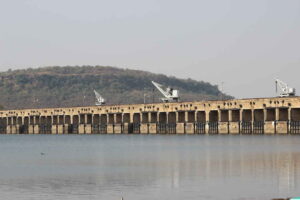
Constructed in 1916, Tighra Dam on Sank river plays a crucial role in the life of Gwalior dwellers (Photo credit: Incredible India)
Another equally overwhelming and must have experience in Gwalior is to visit Tighra Dam. Constructed in 1916, on the Sank river, this dam plays a crucial role in the life of Gwalior dwellers. Water to the city passes through the gates of this dam. The scenic shores of this dam have become a perfect picnic spot for the people residing in Gwalior.
At the foothills of the Gopachal and with dense green forest in sight, Tighra dam is the perfect place to retire after a tiring day of exploring the markets and climbing down from the fort.
For adventure lovers, there are facilities like rafting, water scooting, paddle boats and many more. For those who want to enjoy a calm evening and relish some authentic food from the region, there are plenty of small and big shops selling all kinds of regional as well as special dishes. From seafood stalls, biryani (a rice dish) stalls, Malayalee food stalls to stalls claiming to sell original Belgium chocolates, one can find a variety of outlets, from vendors to high-end restaurants, offering delicacies to fulfil any craving and to suit any budget.









